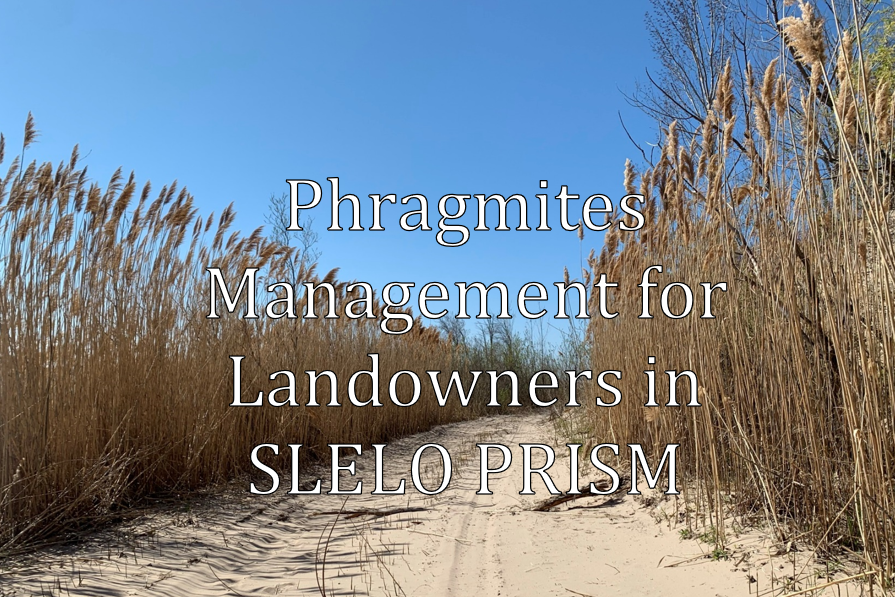This article was contributed by Brittney Rogers-SLELO PRISM, in the 2021 Spring Newsletter.
Invasive species are plants, animals, or microorganisms that are introduced to an ecosystem from which they are not originally from and they cause economic or environmental harm or harm to human health. Though all invasive species must fit into the definition above, not all invasives are created equal. The introduction of these species is often through trade via ballast water, accidental translocation via shipping cargo, or even species that were planted purposely in gardens. Once introduced, some species may disrupt natural communities and ecological processes as they often reproduce and spread rapidly, create monocultures, and utilize important space and nutrients that native species would typically depend on to survive. Beyond the negative impact on native species, invasives can decrease property values, recreational opportunities or even impact aesthetic views.
SLELO provides region-wide coordination for invasive species monitoring and management across the region. Given the extent of our region, we are not able to manage every invasive species everywhere and often seek the support and effort of landowners to participate in the protection of our region. The most commonly reported species to iMapInvasives in the SLELO region include purple loosestrife (Lythrum salicaria), Japanese knotweed (Reynoutria japonica), garlic mustard (Alliaria petiolata), leafy spurge (Euphorbia esula), pale swallow-wort (Vincetoxicum rossicum), common buckthorn (Rhamnus cathartica), and common reed (Phragmites australis ssp australis) which is the second-highest reported species in our region, which will be the species of focus for the remainder of this article.
Phragmites are a non-native species that is believed to have been introduced from Europe in the 19th century via ballast water. This invasive species, in the grass family Poaceae, can grow over 15 feet in height. It often grows in very dense stands or monocultures, which consists of both living and dead stems from previous years’ growth. Mid-summer, Phragmites is in bloom with purple inflorescence, or the complete flower head, which fades to gold as they dry in the winter. Phragmites can spread via their seeds, which are covered in silky hairs and dispersed via humans, animals, and the wind; through underground stems capable of growing roots and shoots called rhizomes, and through stolons which are stems that grow along the soil surface that can grow over 40 feet from the parent plant.

Human-induced disturbances, such as development, may also promote non-native species or Phragmites invasions and dispersal can also occur via construction equipment that was not properly cleaned. Roadsides are also a frequent pathway of spread as they have increased connectivity of ecosystems where transport of plant fragments and seeds can spread. Roadsides in NY are harsh environments with high inputs of sand and salt, vehicular contaminants, and frequent disturbances. Simple ways to prevent the spread of Phragmites include ensuring that the contractors you work with are, cleaning equipment between sites using guidance from this Clean Equipment Protocol, purchasing native plants, and avoiding the use of NYS Prohibited and Regulated Plants as part of the NYCRR Part 575 Invasive Species Regulations. Monitoring for and controlling invasive species at sites with newly laid topsoil and aggregate is also recommended.
Once Phragmites has established on a property, it can quickly grow into dense stands and spread to adjacent areas, so it is important to identify and respond as early as possible. If a population is already well established, it is recommended to work with adjacent property owners to manage and remove the entire population.
Creating a plan for managing an invasive species can help increase the potential for success. Objectives and goals can be directly outlined and shared with neighbors, friends, and professional staff. The following steps – Assessment, Management, and Restoration – should be included in your plan. It is always best to check with your local NYSDEC regional office to determine if permits are needed for your planned project and if so, they will be able to provide you with the necessary applications.
The Benefit of Our Efforts
This summer, SLELO PRISM is working with landowners on North Sandy Pond to manage the Phragmites growing in the dune areas along the end of Renshaw Bay Road. SLELO PRISM will also collaborate with the Eastern Lake Ontario Dunes Foundation for the purpose of developing a Dunes and Wetlands Area (ELODWA) Comprehensive Invasive Species Management Plan. The project team will coordinate and collaborate with land managers at El Dorado Beach Preserve, Black Pond Wildlife Management Area (WMA), Southwick Beach State Park, Lakeview WMA, Sandy Island Beach State Park, Deer Creek Marsh WMA, and private property owners along with a subcontractor to develop the ELOWDA Comprehensive Invasive Species Management Plan utilizing integrated pest management and best management practices which may include invasive species suppression and dune ecology restoration.
Because of the persistence and aggressiveness of Phragmites, long-term management and monitoring may be necessary. While controlling Phragmites on your property may be both time and monetarily expensive, the environmental and social benefits that result from restoring your property far outweigh the costs. Together we can make a difference.
For more information visit our species profile page.
Related
Invasive Species Distribution UpdatesIn "Newsletter"
New Beginings For SLELO PRISMIn "Newsletter"
Volunteering for NatureIn "Newsletter"


